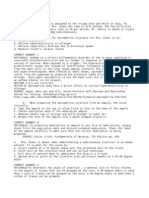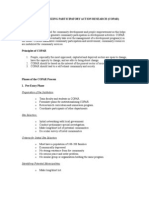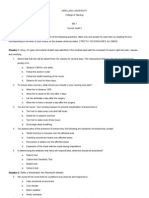Nursing Practice Test
Nursing Practice Test
Uploaded by
Marianne BaquilalaCopyright:
Available Formats
Nursing Practice Test
Nursing Practice Test
Uploaded by
Marianne BaquilalaOriginal Description:
Copyright
Available Formats
Share this document
Did you find this document useful?
Is this content inappropriate?
Copyright:
Available Formats
Nursing Practice Test
Nursing Practice Test
Uploaded by
Marianne BaquilalaCopyright:
Available Formats
Nursing Practice Test/Exam about Communicable Diseases(NLE 1-20)
1. After business trip to an underdeveloped country 3 weeks ago, Chris is diagnosed with hepatitis A. In completing the assessment, the nurse might expect which of the following responses to be most likely associated with the client's contracting of the disease? a) I went hunting to forests and swarmed by mosquitoes b) three months ago, I ate oysters in Kenya c) I drank lemonade from the roadside while on this trip d) my business partner is a hepatitis carrier 2. A client with viral hepatitis has no appetite, and food makes the client nauseated. Which of the following nursing interventions are appropriate? a) explain that high fat diets are usually better tolerated b) encourage foods high in protein c) explain that the majority of calories need to be consumed in the evening hours d) monitor of fluid and electrolyte imbalance 3. Which of the following outcomes would the nurse expect to find in the client who has developed no complications from viral hepatitis? a) decreased absorption of Vitamin K in intestine b) increasing prothrombin time values c) presence of asterexis d) decrease in AST 4. The client has an order to receive purified protein derivatives (PPD) 0.1ml intradermally. The nurse administers the medication utilizing a tuberculin syringe with a: a) 26G, 5/8 inch needle inserted almost parallel to the skin with the bevel side up b) 26G, 5/8 inch needle inserted at a 45deg. angle with bevel side up c) 20G, 1 inch needle inserted almost parallel to the skin with the bevel side up d) 20G, 1 inch needle inserted at a 45deg. angle with bevel side up 5. The nurse reading the PPD skin test for a client with no documented health problems. The site has no induration and a 1mm area of ecchymosis. The nurse interprets that the result is: a) positive b) negative c) needs to be repeated d) borderline 6. The client who is HIV positive has had a Mantoux test. The result shows a 7mm area of induration. The nurse evaluates that this result as: a) negative b) borderline c) positive d) needs to be repeated 7. The nurse reads the client's Mantoux skin test as positive. The nurse notes that the previous tests were negative. The client becomes upset and asks the nurse what this means. The nurse response is based on the understanding that the client has:
a) no evidence of tuberculosis b) client has systemic tuberculosis c) pulmonary tuberculosis d) exposure to tuberculosis 8. The nurse is caring for the client diagnosed with tuberculosis. Which of the following assessments, if made by the nurse, are not consistent with the usual clinical presentation of tuberculosis? a) nonproductive or productive cough b) anorexia and weight loss c) chills and night sweats d) high grade fever 9. The nurse is teaching the client with TB about dietary elements that should be increased in the diet. The nurse suggests that the client increase intake of: a) meats and citrus fruits b) grains and broccoli c) eggs and spinach d) potatoes and fish
10. The client with TB, whose status is being monitored in an ambulatory care clinic, asks the nurse when it is permissible to return to work. The nurse replies that the client may resume employment when: a) two sputum cultures are negative b) five sputum cultures are negative c) a sputum culture and a chest x-ray is negative d) a sputum culture and a PPD test are negative 11. The client with TB is being started on anti-TB therapy with Isoniazid (INH). The nurse assesses that which of the following baseline studies has been completed before giving the client the first dose? a) coagulation times b) electrolytes c) serum creatinine d) liver enzymes 12. The nurse has given the client with tuberculosis instructions for proper handling and disposal of respiratory secretions. The nurse evaluates that the client understands the instruction if the client verbalizes to: a) wash hands at least four times a day b) turn the head to the side if coughing or sneezing c) discard the used tissues in the plastic bag d) brush the teeth and rinse the mouth once a day
13. The client has been taking Isoniazid for month and a half. The client complains to the nurse about numbness, paresthesias, and tingling in the extremities. The nurse interprets that the client is experiencing: a) small blood vessel spasm b) impaired peripheral circulation c) hypercalcemia
d) peripheral neuritis 14. The client with AIDS is diagnosed with cutaneous Kaposi's sarcoma. Based on this diagnosis, the nurse understands that his has been determined by which of the following? a) appearance of reddish blue lesions noted on the skin b) swelling in the lower extremities c) punch biopsy of the cutaneous lesions d) swelling in the genital area 15. Which of the following individuals is least likely at risk for the development of Kaposi's sarcoma? a) a man with a history of same sex partners b) a renal transplant client c) a client receiving antineoplastic medications d) an individual working in an environment where exposure to asbestos exists 16. The clinic nurse assesses the skin of the client with a diagnosis of psoriasis. Which of the following characteristics is not associated with this skin disorder? a) discoloration and pitting of the nails b) silvery white, scaly patches on the scalp, elbows, knees, and sacral regoins c) complaints of pruritus d) red purplish, scaly lesions 17. The nurse is assigned to care for a client with herpes zoster. Which of the following characteristics does the nurse expect to note when assessing the lesions of this infection? a) a generalized body rash b) small, blue-white spots with a red base c) a fiery red, edematous rash on the cheeks d) clustered skin vesicles 18. The nurse manager is panning in the clinical assignments for the day. Which of the following staff members would not be assigned to the client with herpes zoster? a) the nurse who had chicken fox during child hood b) the new nurse who never had german measles c) the nurse who never had enteric fever d) the new nurse who had flu vaccine 19. The nurse plans to instruct a client with candidiasis (thrush) of the oral cavity about how to care for the disorder. Which of the following is not a component of instructions? a) to rinse the mouth four times daily with a commercial mouthwash b) to avoid spicy foods c) to avoid citrus fruits and hot liquids d) to eat foods that are liquid 20. The clinic nurse inspects the skin of client suspect of having scabies.Which of the following assessment findings would the nurse note if this disorder were present? a. the appearance of vesicles or pustules with a thick, honey colored crust b) the presence of white patches scattered about the trunk c) multiple straight or wavy, threadlike lines beneath the skin d) patchy hair loss and round neck macules with scales
ANSWERS 1) C ..... 2) D ..... 3) D ..... 4) A ..... 5) B 6) C ..... 7) D ..... 8) D ..... 9) A ..... 10) A 11) D ..... 12) C ..... 13) D ..... 14) A ..... 15) C 16) D ..... 17) D ..... 18) B ..... 19) A ..... 20) C
You might also like
- Maternal & Child Care Nursing ReviewDocument37 pagesMaternal & Child Care Nursing Reviewɹǝʍdןnos98% (130)
- The Folia Melodies - R.HudsonDocument23 pagesThe Folia Melodies - R.HudsonFrancisco Berény Domingues100% (1)
- William A. Gardner - Introduction To Random Processes - With Applications Signals and Systems. Second Edition - McGraw-Hill (1990)Document560 pagesWilliam A. Gardner - Introduction To Random Processes - With Applications Signals and Systems. Second Edition - McGraw-Hill (1990)Fardin KhanNo ratings yet
- Comprehensive Examination 10Document8 pagesComprehensive Examination 10명수김No ratings yet
- NURSING EMERGENCIES. 10 BASED TEST QUESTIONS WITH BIBLIOGRAPHYFrom EverandNURSING EMERGENCIES. 10 BASED TEST QUESTIONS WITH BIBLIOGRAPHYNo ratings yet
- Hema, Gut Take Home TestDocument6 pagesHema, Gut Take Home TestNom NomNo ratings yet
- Community Health Nursing Achievement Test FIRST SEMESTER 2021-2022Document14 pagesCommunity Health Nursing Achievement Test FIRST SEMESTER 2021-2022Matelyn OargaNo ratings yet
- UntitledDocument20 pagesUntitledstuffednurse100% (1)
- MS Question Wave 1Document9 pagesMS Question Wave 1mark balisnomoNo ratings yet
- D.s.s.aiims Prepration Test Series - 8Document36 pagesD.s.s.aiims Prepration Test Series - 8Dr-Sanjay SinghaniaNo ratings yet
- Practice Test Questions Downloaded From FILIPINO NURSES CENTRALDocument13 pagesPractice Test Questions Downloaded From FILIPINO NURSES CENTRALFilipino Nurses CentralNo ratings yet
- Nle - July 2011Document12 pagesNle - July 2011shenric16100% (2)
- Peptic UlcerDocument53 pagesPeptic UlcerHoney Lyn AlebioNo ratings yet
- Answers and RationaleDocument6 pagesAnswers and RationaleSheana TmplNo ratings yet
- Core CompetencyDocument9 pagesCore CompetencyCharm BarinosNo ratings yet
- Psyche 1Document3 pagesPsyche 1Aijem RyanNo ratings yet
- Test Questions For Oncologic DisordersDocument6 pagesTest Questions For Oncologic Disorderspatzie100% (2)
- 1Document60 pages1Ciena MaeNo ratings yet
- CHN Post Test1Document13 pagesCHN Post Test1Cstive ValenzuelaNo ratings yet
- 2024 NP1 Q&aDocument21 pages2024 NP1 Q&aEnna EstrellaNo ratings yet
- Carl Rogers Erik Erikson Ivan Pavlov Albert Ellis B.F SkinnerDocument3 pagesCarl Rogers Erik Erikson Ivan Pavlov Albert Ellis B.F Skinnermark OrpillaNo ratings yet
- For A Client in Hepatic Coma, Which Outcome Would Be The Most Appropriate?Document14 pagesFor A Client in Hepatic Coma, Which Outcome Would Be The Most Appropriate?Erica Veluz LuyunNo ratings yet
- Medical Surgical Nursing Practice Exam IDocument13 pagesMedical Surgical Nursing Practice Exam IEngelbert Addongan100% (1)
- CHN PretestDocument7 pagesCHN PretestMary Shane MoraldeNo ratings yet
- Chapter 10: Abdominal Disorders: Multiple ChoiceDocument5 pagesChapter 10: Abdominal Disorders: Multiple ChoiceJamieNo ratings yet
- Care of Adults 28 Hematological and Oncological ManagementDocument40 pagesCare of Adults 28 Hematological and Oncological ManagementGaras AnnaBerniceNo ratings yet
- CoparDocument4 pagesCopar.fayefen100% (4)
- MS 1 ExamDocument11 pagesMS 1 ExamNeneChieffy Palmares CaligdongNo ratings yet
- np1 RatioDocument17 pagesnp1 RatioArnie Jude CaridoNo ratings yet
- Preboard Examination - NP5 STUDENTDocument11 pagesPreboard Examination - NP5 STUDENTAli IgnacioNo ratings yet
- Heart Failure NCLEX QuestionsDocument5 pagesHeart Failure NCLEX QuestionsMelodia Turqueza GandezaNo ratings yet
- Answer and Rationale Community Health NursingDocument15 pagesAnswer and Rationale Community Health NursingCharles Gerard B. BeluanNo ratings yet
- Silvestri Chapter 46 Ed56ADocument31 pagesSilvestri Chapter 46 Ed56ABobet Reña100% (1)
- Post Test - Prof Ad - Prof. Fuentes (SC)Document2 pagesPost Test - Prof Ad - Prof. Fuentes (SC)Kristen FajilanNo ratings yet
- Remedial Exam PsychDocument7 pagesRemedial Exam PsychPrince Rener Velasco PeraNo ratings yet
- Drills-1 Np4 AquinoDocument11 pagesDrills-1 Np4 AquinoSolah SalvatoreNo ratings yet
- Tut 3Document3 pagesTut 3Bobet ReñaNo ratings yet
- Medsurg Reviewer1Document27 pagesMedsurg Reviewer1Angelie BigayNo ratings yet
- Perioperative Nursing QuestionsDocument47 pagesPerioperative Nursing QuestionsAnsherina Murillo AguilarNo ratings yet
- Metabolic and Endocrine ManagementDocument42 pagesMetabolic and Endocrine ManagementAlyssa MontimorNo ratings yet
- Gastrointestinal Disorders 1st ClassDocument70 pagesGastrointestinal Disorders 1st ClassBharat ThapaNo ratings yet
- PsychDocument3 pagesPsychJo Hn VengzNo ratings yet
- GastrointestinalDocument69 pagesGastrointestinalRodney MacansantosNo ratings yet
- Test Taking 30 Items KeyDocument7 pagesTest Taking 30 Items KeyNurse HoomanNo ratings yet
- Np1preboardnle With AnswerDocument17 pagesNp1preboardnle With AnswerRandyNo ratings yet
- Q&A FractureDocument13 pagesQ&A FractureRed JimenoNo ratings yet
- Funda III - NielDocument4 pagesFunda III - NielnielallisonNo ratings yet
- Medical Surgical Nursing Exam 5Document27 pagesMedical Surgical Nursing Exam 5St. MatthewGalnayonMa. Alyza KaeNo ratings yet
- Cp104 Bleeding Disordes Quiz With RationaleDocument6 pagesCp104 Bleeding Disordes Quiz With RationaleMay Princes Torregosa AbucejoNo ratings yet
- IR 2022 Pediatric Nursing Handouts - Prof. Ma. Teresa VanguardiaDocument15 pagesIR 2022 Pediatric Nursing Handouts - Prof. Ma. Teresa VanguardiaJamie John EsplanadaNo ratings yet
- Questions - RespiDocument37 pagesQuestions - RespiKristine CastilloNo ratings yet
- HeheezjghDocument7 pagesHeheezjghDemiar Madlansacay QuintoNo ratings yet
- GI Endo Eval Exam IIDocument7 pagesGI Endo Eval Exam IICraig Jesse B. LardizabalNo ratings yet
- 260 QuestionsDocument42 pages260 QuestionsMaryjoy Mertalla50% (4)
- Chapter 30 Nutrition and Digestive SystemDocument8 pagesChapter 30 Nutrition and Digestive SystemNeil Dave SuarezNo ratings yet
- The politics of hunger: Protest, poverty and policy in England, <i>c.</i> 1750–<i>c.</i> 1840From EverandThe politics of hunger: Protest, poverty and policy in England, <i>c.</i> 1750–<i>c.</i> 1840No ratings yet
- Ventricular Septal Defect, A Simple Guide To The Condition, Treatment And Related ConditionsFrom EverandVentricular Septal Defect, A Simple Guide To The Condition, Treatment And Related ConditionsNo ratings yet
- The Ride of Your Life: What I Learned about God, Love, and Adventure by Teaching My Son to Ride a BikeFrom EverandThe Ride of Your Life: What I Learned about God, Love, and Adventure by Teaching My Son to Ride a BikeRating: 4.5 out of 5 stars4.5/5 (2)
- Nursing Practice Test/Exam About Communicable Diseases (NLE 1-20)Document4 pagesNursing Practice Test/Exam About Communicable Diseases (NLE 1-20)jay5ar5jamorabon5tor100% (1)
- Communicable Diseases ExamsDocument4 pagesCommunicable Diseases ExamsLloyd LozanoNo ratings yet
- Community 5 April 23Document8 pagesCommunity 5 April 23KimTot OctavianoNo ratings yet
- Communicable Diseases: HIV PositiveDocument20 pagesCommunicable Diseases: HIV Positivepinoy_nurse100% (1)
- Maternal and Child Health Practice IDocument23 pagesMaternal and Child Health Practice Igaea_myzticmoonNo ratings yet
- Nursing Practice TestDocument4 pagesNursing Practice TestMarianne BaquilalaNo ratings yet
- Drug Study Atenolol, Cefuroxime, SimvastatinDocument4 pagesDrug Study Atenolol, Cefuroxime, Simvastatinpaupaulala100% (4)
- Jeng 1Document8 pagesJeng 1Marianne BaquilalaNo ratings yet
- HCVD KoDocument10 pagesHCVD KoMarianne BaquilalaNo ratings yet
- Intrnship Report On WapdaDocument106 pagesIntrnship Report On WapdaNarain MenghwarNo ratings yet
- MICEDocument37 pagesMICECeleste Torino DigalNo ratings yet
- Final Gradation List of JrSES Teachers 2018 01-55-02pmb5dd867deDocument349 pagesFinal Gradation List of JrSES Teachers 2018 01-55-02pmb5dd867deprabhudattapujhari4No ratings yet
- Educ 104e Media Lesson Plan TemplateDocument3 pagesEduc 104e Media Lesson Plan Templateapi-482008751No ratings yet
- кр 2Document36 pagesкр 2Natalia LutvunivNo ratings yet
- Amphi #3. Competing in International Markets 1Document59 pagesAmphi #3. Competing in International Markets 1jean.jacquesNo ratings yet
- Alicia Myers' Garment Construction PortfolioDocument33 pagesAlicia Myers' Garment Construction PortfolioAlicia MyersNo ratings yet
- XAT Specific Instructions XAT 2024Document2 pagesXAT Specific Instructions XAT 2024bhole9615No ratings yet
- RP5690LUTP010R1l0Report1Nov00702006 2 PDFDocument152 pagesRP5690LUTP010R1l0Report1Nov00702006 2 PDFFreekado GratisNo ratings yet
- L30 - FPSC Paper Mill Colony C38/1, Gurdwara Road, Siddheshwar LucknowDocument4 pagesL30 - FPSC Paper Mill Colony C38/1, Gurdwara Road, Siddheshwar LucknowShamsuddin ShamsNo ratings yet
- Job 1 - 8-12 SermonDocument12 pagesJob 1 - 8-12 SermonWes BredenhofNo ratings yet
- Share Capital - TheoryDocument44 pagesShare Capital - Theoryabhikumar08081993No ratings yet
- Zulzer Ohh E00581 PDFDocument8 pagesZulzer Ohh E00581 PDFJorge OportoNo ratings yet
- Pop Up The Art of Dimensional Moving Paper Designs 3Document20 pagesPop Up The Art of Dimensional Moving Paper Designs 3Rodrigo L. B.100% (1)
- (Loga.vn) THI CHUYÊN ĐỀDocument10 pages(Loga.vn) THI CHUYÊN ĐỀNaruto SakuraNo ratings yet
- Corpus Christi School: Cagayan de Oro CityDocument6 pagesCorpus Christi School: Cagayan de Oro CityCathy GabroninoNo ratings yet
- NYS Infanticide Law GENOCIDE Challenged in USDC NDNY 19-cv-202 in Re Strunk V NYS Et Al. - As of 3-15-2019Document254 pagesNYS Infanticide Law GENOCIDE Challenged in USDC NDNY 19-cv-202 in Re Strunk V NYS Et Al. - As of 3-15-2019Christopher Earl Strunk100% (5)
- E-SCRA Begosa vs. ChairmanDocument12 pagesE-SCRA Begosa vs. Chairmanflordelei hocateNo ratings yet
- 1 - OSCE TemplateDocument16 pages1 - OSCE TemplateFatimaNo ratings yet
- Events After Balancesheet Notes-1Document28 pagesEvents After Balancesheet Notes-1sudeis omaryNo ratings yet
- Finnikin of The Rock by Melina Marchetta - Chapter SamplerDocument34 pagesFinnikin of The Rock by Melina Marchetta - Chapter SamplerCandlewick Press25% (4)
- GENERIC Business Mathematics FinalDocument6 pagesGENERIC Business Mathematics FinalMelissa KleinNo ratings yet
- MEYC 6500 Manual de Usuario - EngDocument76 pagesMEYC 6500 Manual de Usuario - Engsoporte03No ratings yet
- Mamferosda Mata AtlnticaDocument93 pagesMamferosda Mata AtlnticaSôniaRodaNo ratings yet
- Introduction To Data Mining - Rev PDFDocument1 pageIntroduction To Data Mining - Rev PDFlhy20283No ratings yet
- Risk (Disambiguation) : Jump To Navigation Jump To Search UncertaintyDocument5 pagesRisk (Disambiguation) : Jump To Navigation Jump To Search UncertaintySenthilkumar SellaperumalNo ratings yet
- The Arenaof OtheringDocument25 pagesThe Arenaof OtheringGiNo ratings yet
- People V AmaguinDocument11 pagesPeople V AmaguinIrish GarciaNo ratings yet































































































